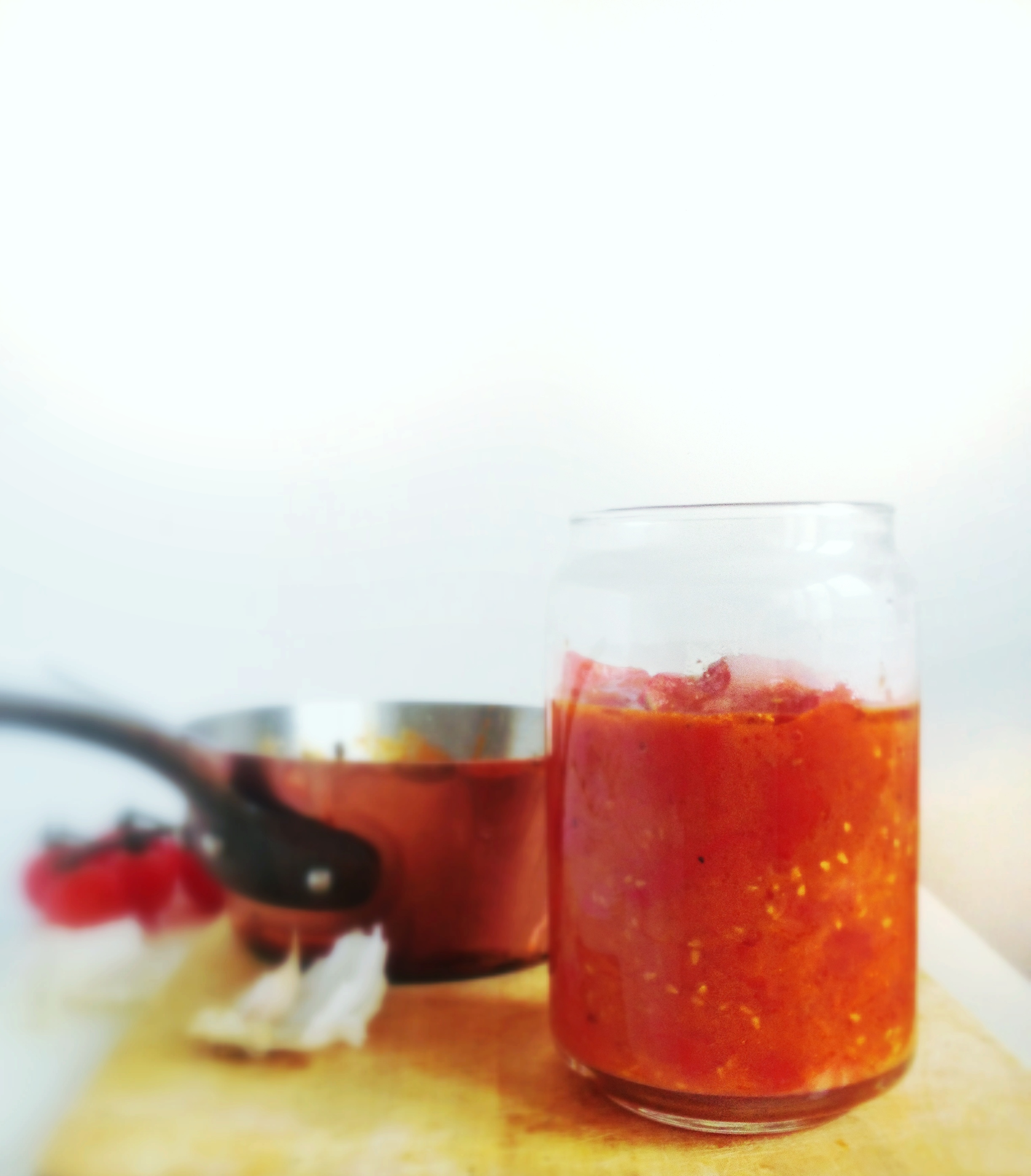 Back when my wife and I could go on holiday without having to take an entire nursery with us, we spent a week in the January gloom of a tiny Ligurian village called Apricale. Out of season and with most of the bars, restaurants and shops closed, it was pretty, quiet and pretty quiet. Of the places that were open, the one we went to most was a simple café called Locanda Tarocchi, which served amazing food that was simple but really delicious. Their antipasti was the best I’ve ever had anywhere, and their spaghetti with tomato sauce was beautiful, fresh and sweet. When I got home I tried to recreate it – and after many attempts I think I’ve got pretty close with this one.Ingredients6 tbsp good quality olive oil4 cloves of garlic, peeled1 tsp of white wine vinegar1 tbsp sugar250g of cherry tomatoes, with the vineA pinch of salt1 tsp of paprikaMethod1. In a large frying pan with the heat on already, pour in the olive oil. Add the garlic cloves and cook them gently, turning occasionally until they are starting to colour and soften. Remove the garlic cloves and throw them away, or as I do, mash them up and spread on a piece of crusty bread for a snack.2. Add the vines from the tomatoes and give them a good stir round, coating them in oil and releasing their wonderful aroma into the oil.3. Throw in the tomatoes, shake the pan around for a bit and season well with the salt, paprika and sugar. Leave the tomatoes to cook for about five minutes, or until collapsing, give them a good stir and add the vinegar. Cook for a further five minutes, adjust the seasoning and add a dash of water if the sauce is too thick. Remove the vines and serve with spaghetti and plenty of parmesan.
Back when my wife and I could go on holiday without having to take an entire nursery with us, we spent a week in the January gloom of a tiny Ligurian village called Apricale. Out of season and with most of the bars, restaurants and shops closed, it was pretty, quiet and pretty quiet. Of the places that were open, the one we went to most was a simple café called Locanda Tarocchi, which served amazing food that was simple but really delicious. Their antipasti was the best I’ve ever had anywhere, and their spaghetti with tomato sauce was beautiful, fresh and sweet. When I got home I tried to recreate it – and after many attempts I think I’ve got pretty close with this one.Ingredients6 tbsp good quality olive oil4 cloves of garlic, peeled1 tsp of white wine vinegar1 tbsp sugar250g of cherry tomatoes, with the vineA pinch of salt1 tsp of paprikaMethod1. In a large frying pan with the heat on already, pour in the olive oil. Add the garlic cloves and cook them gently, turning occasionally until they are starting to colour and soften. Remove the garlic cloves and throw them away, or as I do, mash them up and spread on a piece of crusty bread for a snack.2. Add the vines from the tomatoes and give them a good stir round, coating them in oil and releasing their wonderful aroma into the oil.3. Throw in the tomatoes, shake the pan around for a bit and season well with the salt, paprika and sugar. Leave the tomatoes to cook for about five minutes, or until collapsing, give them a good stir and add the vinegar. Cook for a further five minutes, adjust the seasoning and add a dash of water if the sauce is too thick. Remove the vines and serve with spaghetti and plenty of parmesan.
Recipes
Homemade smoked tomato ketchup
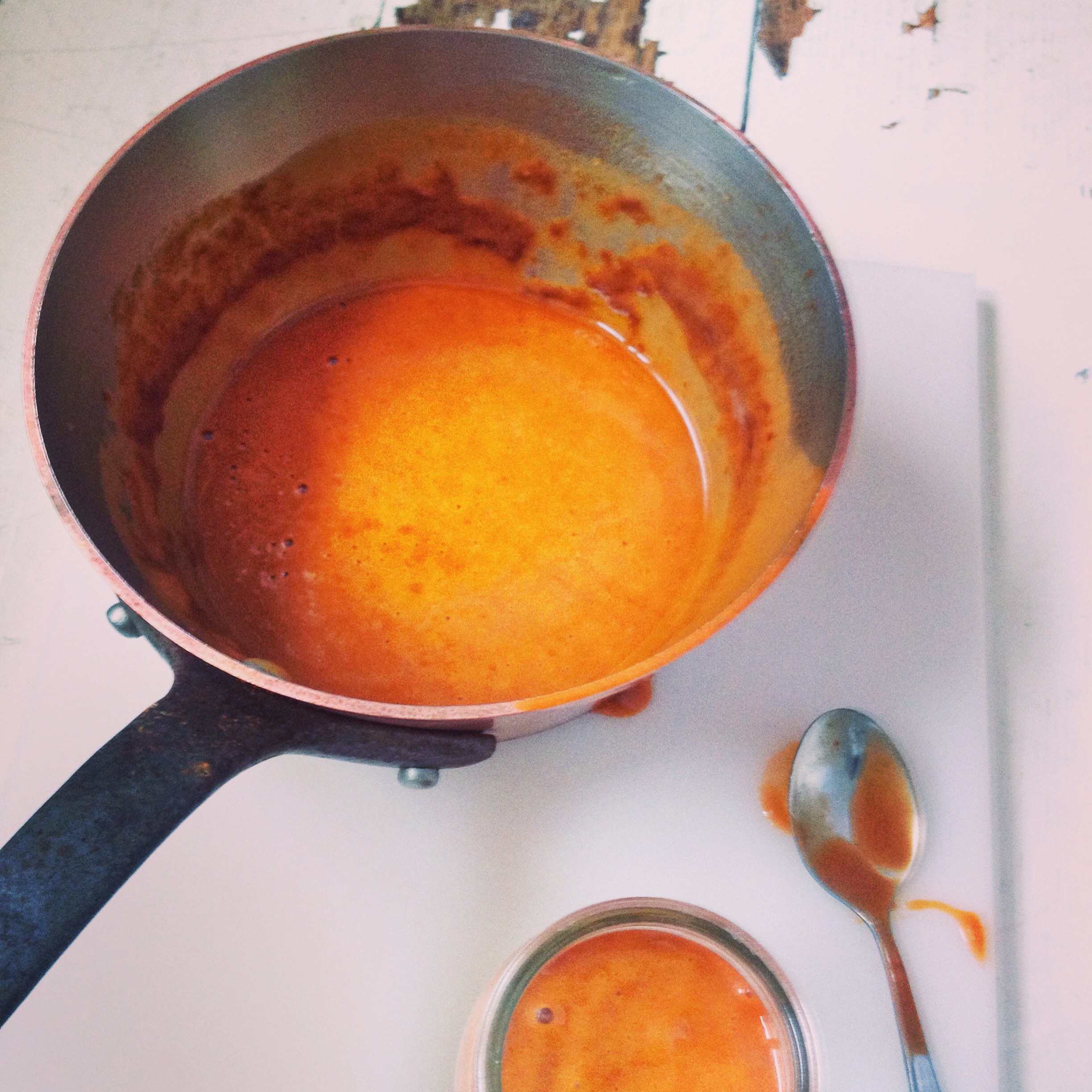 Bought ketchup is a permanent fixture in our fridge, mainly to go with a certain two-year-old’s fish fingers. This homemade version, however, is a little more grown up. I like my breakfast to have a little kick to it and this has the smokiness of paprika and red peppercorns to give a twist to my sausage sandwiches. The agar and xanthan give it a lovely light fluidity and creaminess.Ingredients
Bought ketchup is a permanent fixture in our fridge, mainly to go with a certain two-year-old’s fish fingers. This homemade version, however, is a little more grown up. I like my breakfast to have a little kick to it and this has the smokiness of paprika and red peppercorns to give a twist to my sausage sandwiches. The agar and xanthan give it a lovely light fluidity and creaminess.Ingredients
- 450g cherry tomatoes, and the vine
- 1 tbsp of sugar
- A pinch of salt
- 8 red peppercorns
- 1 tbsp of smoked paprika
- A dash of balsamic vinegar
- A dash of red wine vinegar
- A dash of olive oil
- A large dash of Worcestershire sauce
- 10 drops of Angostura bitters
- 1 tsp of mustard seeds
- A splash of water
- A splash of red wine
- A few drops of Tabasco sauce
- ½ tsp of agar and 1/8 tsp of xanthan powder. Both available in health food shops
Method
- Cook the tomatoes and their vines until soft in a heavy-bottomed pan with some olive oil, the peppercorns and a pinch of salt. Squash the tomatoes with a wooden spoon.
- Add the paprika, sugar, balsamic, Worcester sauce, Angostura bitters, mustard seeds and the red wine vinegar, then cook for five minutes or until the sauce begins to thicken. Add a little water if it's getting too thick.
- Strain through a sieve and keep the solids. Set the liquid to one side.
- Put the solids back into the pan and add the red wine and a splash of water. Cook for five minutes. Strain this through muslin into the set-aside liquid.
- Add the agar and xanthan, bring to the boil, decant and leave to cool until set. With a hand blender, blitz the mixture until creamy and store in the fridge in a spotlessly clean airtight container such as a kilner jar.
Rabbit terrine with asparagus, pancetta and peas
 This dish is so pretty, but essentially my rabbit terrine is a big slab of meat, freshened by the addition of peas and asparagus. Served with a pickled salad and a few truffle shavings, it made a delicious lunch on a recent shoot. Serves: 6-8 peoplePrep time: 15 minutes Cooking time: 90 minutesIngredients1 rabbit, skinned and cleaned. Reserve the kidneys and liver150g pork belly, meat and fat separated500ml warm vegetable stock2 sheets of gelatine8 asparagus spears, blanched20 slices of pancetta200g of petit pois1 tbsp saltPepper to seasonMethod
This dish is so pretty, but essentially my rabbit terrine is a big slab of meat, freshened by the addition of peas and asparagus. Served with a pickled salad and a few truffle shavings, it made a delicious lunch on a recent shoot. Serves: 6-8 peoplePrep time: 15 minutes Cooking time: 90 minutesIngredients1 rabbit, skinned and cleaned. Reserve the kidneys and liver150g pork belly, meat and fat separated500ml warm vegetable stock2 sheets of gelatine8 asparagus spears, blanched20 slices of pancetta200g of petit pois1 tbsp saltPepper to seasonMethod
- Heat the oven to 150°C.
- Mince the rabbit and pork belly meat, and finely slice the fat (or get your butcher to do it for you). Add the rabbit, pork, fat, salt, and a good twist of pepper to a bowl and mix well.
- Soften the gelatine in a little water for ten minutes, then drain and squeeze out, then set aside.
- Line a terrine dish with the pancetta, hanging the edges over, so that you can fold them back and cover the top.
- Spoon a layer of the rabbit and pork into the bottom and spread well. Cover with a layer of peas. Add another layer of rabbit and pork mix. Add a layer of asparagus. Cover with the remaining meat.
- Pour in the gelatine and stock, then press down. Fold over the pancetta. Place the terrine in a baking tray half-filled with hot water and cook for one and a half hours.
- Remove from the oven, take the lid off and weight down with a piece of cardboard and some tin cans, then leave it in the fridge overnight.
- Remove from the fridge half an hour before serving, turn upside down onto a board and slice. Serve with a pickled salad.
The Modern Husband talks food styling on the radio
 As I was approaching the final few days of a 170-recipe cookbook I was commissioned to write and style, I had a call from London community station Zone One radio as they were doing a programme about food photography. Could they come along to the shoot to talk to me?Their journalist joined us on the shoot to find out more about food styling and photography. We were in the middle of shooting a slow roast pork belly and the conversation centred around how to make the food look as appetising as possible. Food should always look relaxed and natural, even if it’s a fancy recipe – and that can mean choosing the right props and deciding on the most flattering angle. You can listen to the show here: http://www.zoneoneradio.com/2013/05/ingoodtaste-food-photography-with-jay.html?m=1
As I was approaching the final few days of a 170-recipe cookbook I was commissioned to write and style, I had a call from London community station Zone One radio as they were doing a programme about food photography. Could they come along to the shoot to talk to me?Their journalist joined us on the shoot to find out more about food styling and photography. We were in the middle of shooting a slow roast pork belly and the conversation centred around how to make the food look as appetising as possible. Food should always look relaxed and natural, even if it’s a fancy recipe – and that can mean choosing the right props and deciding on the most flattering angle. You can listen to the show here: http://www.zoneoneradio.com/2013/05/ingoodtaste-food-photography-with-jay.html?m=1
Slow roast, spiced, crackled pork sandwiches
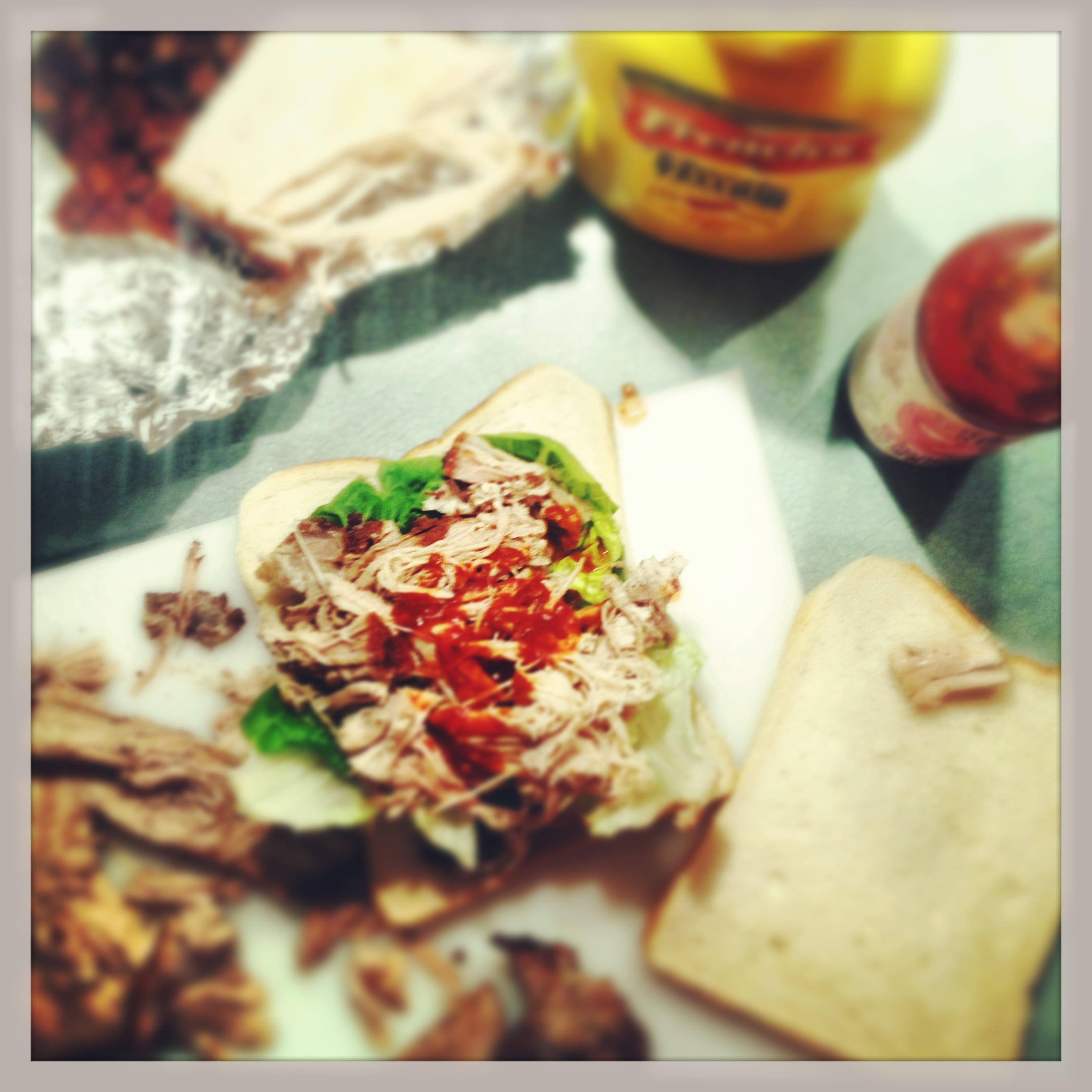 I cannot resist sharing this recipe. It's a dish based on my love of American food, which was stoked by many early mornings watching Man v. Food to keep myself awake as I cuddled my newborn son.Although the challenges were sometimes a bit grotesque in the programme, the places, ingredients, regional differences and cooking techniques have stuck in my mind.For this recipe, I don't have a smoker big enough to fit brisket in. Nor can I slow-cook a whole pig for 24 hours over hickory chips, much as I’d like to. So I've taken the best bits of my Geordie granny's 'pork with crackling' recipe, spiced it up a little and mixed it with some of my hazy Man v. Food memories – and made myself a very delicious sandwich. It's not something you can quickly knock up, but get everything ready the day before and you will have a week's worth of joy and a lifetime's worth of requests for your famous pork sandwich.Serves: 6Prep time: 20 minutes, plus overnight in the fridgeCooking time: 180 minutesIngredients1.5kg pork belly2 star anise1 5cm piece of cassia bark, or cinnamon1 tsp cloves1 tsp Szechuan peppercorns1 tbsp fennel seeds1 onion1 leek2 carrotsSaltMethod
I cannot resist sharing this recipe. It's a dish based on my love of American food, which was stoked by many early mornings watching Man v. Food to keep myself awake as I cuddled my newborn son.Although the challenges were sometimes a bit grotesque in the programme, the places, ingredients, regional differences and cooking techniques have stuck in my mind.For this recipe, I don't have a smoker big enough to fit brisket in. Nor can I slow-cook a whole pig for 24 hours over hickory chips, much as I’d like to. So I've taken the best bits of my Geordie granny's 'pork with crackling' recipe, spiced it up a little and mixed it with some of my hazy Man v. Food memories – and made myself a very delicious sandwich. It's not something you can quickly knock up, but get everything ready the day before and you will have a week's worth of joy and a lifetime's worth of requests for your famous pork sandwich.Serves: 6Prep time: 20 minutes, plus overnight in the fridgeCooking time: 180 minutesIngredients1.5kg pork belly2 star anise1 5cm piece of cassia bark, or cinnamon1 tsp cloves1 tsp Szechuan peppercorns1 tbsp fennel seeds1 onion1 leek2 carrotsSaltMethod
- Lightly toast the spices in a dry sauté pan and grind to a powder with a pinch of salt.
- Score the skin of the pork and pour boiling water all over it. This will help dry it out.
- Pat dry with kitchen towel and rub in the spice mix, then leave uncovered in the fridge overnight.
- Heat the oven to 220°C.
- Chop the onion, leek and carrots. Put them in a roasting tray, then put a rack over them and the pork on that.
- Cook for 25 minutes, then turn the heat down to 130°C and cook for a further two and a half hours. Check the skin is crisp. If not, turn up the heat to 220°C and cook for a further 10-15 minutes.
- Leave the pork to rest a while, then tear apart and serve in bread with spring onion, lettuce, mustard and smoky chilli sauce.
A search for the perfect chilli con carne
 I would love to go to Texas for the barbecues and the chilli. I want to eat 24-hour smoked brisket and tender ribs with the meat falling off them. What I’d really like to try is the way the long, slow cooking over smoke makes everything pink, juicy and uniquely charred in a way that you’ll never be able to recreate in the home kitchen.Until recently, I'd only ever eaten insipid chilli, with perhaps a touch of cumin or chilli powder to tell you that it wasn't a bolognese. So when I was asked to make it for my Dad’s 60th birthday, I was determined to find a recipe that would make me rethink it.I researched its history and how it is made in the chilli heartland of Texas, and finally came up with this version, which I think is truly delicious and has totally transformed my view of the dish.Serves: 6 peopleCooking time: 3 hours Ingredients500g beef skirt or brisket, thinly sliced2 racks of pork ribs2 large onions, finely chopped4 cloves of garlic, crushed4 jalapeño chillies6 tbsp brown sugar2 bottles of lager200ml apple juice250ml tomato ketchupCider vinegarDijon mustard2 tbsp Worcestershire sauce1 tbsp Paprika1 tbsp chilli powder1 tbsp ground cumin1 tbsp Cayenne pepper1 Chipotle pepper1 Ancho chilli1 large green pepper, sliced1 tin red kidney beansFresh coriander leaves to garnishMethod
I would love to go to Texas for the barbecues and the chilli. I want to eat 24-hour smoked brisket and tender ribs with the meat falling off them. What I’d really like to try is the way the long, slow cooking over smoke makes everything pink, juicy and uniquely charred in a way that you’ll never be able to recreate in the home kitchen.Until recently, I'd only ever eaten insipid chilli, with perhaps a touch of cumin or chilli powder to tell you that it wasn't a bolognese. So when I was asked to make it for my Dad’s 60th birthday, I was determined to find a recipe that would make me rethink it.I researched its history and how it is made in the chilli heartland of Texas, and finally came up with this version, which I think is truly delicious and has totally transformed my view of the dish.Serves: 6 peopleCooking time: 3 hours Ingredients500g beef skirt or brisket, thinly sliced2 racks of pork ribs2 large onions, finely chopped4 cloves of garlic, crushed4 jalapeño chillies6 tbsp brown sugar2 bottles of lager200ml apple juice250ml tomato ketchupCider vinegarDijon mustard2 tbsp Worcestershire sauce1 tbsp Paprika1 tbsp chilli powder1 tbsp ground cumin1 tbsp Cayenne pepper1 Chipotle pepper1 Ancho chilli1 large green pepper, sliced1 tin red kidney beansFresh coriander leaves to garnishMethod
- Make the barbecue sauce by heating some minced onion, two cloves of crushed garlic, ketchup, two tablespoons of brown sugar, the mustard, vinegar and apple juice. Pour in the Worcestershire sauce, leave to simmer for a couple of minutes, then set aside.
- Heat some oil in a large, heavy-based saucepan and sauté the onion and garlic until soft. Add the meat and season well. Cook for a few minutes and add the chillies and spices. Stir and add the pork ribs and cook until browned.
- Add the green pepper, pour in the lager and barbecue sauce, stir well, bring to the boil then reduce the heat to a very low simmer and cook for about two and a half hours. Add the kidney beans, cook for a further half hour and serve garnished with coriander.
Strawberries in red wine: a French classic
 Madame Suzy Ghirlando, my Great Aunt, is 95. She lives in a 1960s Paris apartment that she bought new, in which the furniture and wallpaper has probably never changed. I love sitting with her in the narrow galley kitchen drinking red wine, eating cheese, and talking.Contrary to the idea that all French people eat amazingly all of the time, Auntie Suzy’s ‘signature dish’ is spaghetti with butter and cheese. However, she did introduce me to this really easy yet delicious dessert. I’ve added thyme and black pepper to this recipe, but apart from that, it remains unchanged. Serves: 4 peoplePrep time: 10 mins, plus marinatingIngredients1 punnet strawberries150ml fresh orange juice150ml red wineA few thyme sprigsA pinch of mustard cress4 tbsp caster sugarA twist of black pepperMethod
Madame Suzy Ghirlando, my Great Aunt, is 95. She lives in a 1960s Paris apartment that she bought new, in which the furniture and wallpaper has probably never changed. I love sitting with her in the narrow galley kitchen drinking red wine, eating cheese, and talking.Contrary to the idea that all French people eat amazingly all of the time, Auntie Suzy’s ‘signature dish’ is spaghetti with butter and cheese. However, she did introduce me to this really easy yet delicious dessert. I’ve added thyme and black pepper to this recipe, but apart from that, it remains unchanged. Serves: 4 peoplePrep time: 10 mins, plus marinatingIngredients1 punnet strawberries150ml fresh orange juice150ml red wineA few thyme sprigsA pinch of mustard cress4 tbsp caster sugarA twist of black pepperMethod
- Hull and slice the strawberries in half and put in a bowl.
- Sprinkle them with sugar and leave to marinate for 20-25 minutes.
- Add the orange juice and red wine, stir gently and taste. Add a little sugar if necessary.
- Leave for a further five minutes and serve with the pepper, cress and thyme.
The best Salsa Verde ever
 …well, in my humble opinion it is. This is what we’re having for dinner tonight. I was craving some bright, summery flavours, and they don’t get much better than in Salsa Verde. It translates as ‘green sauce’, and that is exactly what it is – basically pesto with added panache and interest.You can tweak the proportion of herbs to your taste, but the depth comes from the capers and anchovies. Don’t be afraid of the anchovy sauce; it doesn't taste fishy in this – it just rounds everything off nicely. If you’re adamant about not including it, or are vegetarian, strong black or purple olives make a good substitute. Finally, I’ve replaced half the usual olive oil with rapeseed oil to cut down on the saturated fat, but feel free to use just one or other if you prefer.I think this goes best with seared tuna and a tomato salad, but it is also delicious with lamb or chicken. Either way, when the words “the smell of that is driving me wild” are spoken in your kitchen, you know you’re onto a winner.I love this version – plus it’s incredibly easy to make – but I’d be interested to know if anyone out there has an even better Salsa Verde recipe.Serves: 4 peoplePrep time: 10 minsIngredients2 small bunches basil1 large bunch coriander, including stems1 large bunch parsley1 small bunch mint1 clove garlic, chopped2 tbsp capers2 tbsp dijon mustardOlive oilRapeseed oil4 dashes Angostura bittersLemon juice3 tarragon leaves1 tbsp anchovy sauce6 black olivesSaltMethod
…well, in my humble opinion it is. This is what we’re having for dinner tonight. I was craving some bright, summery flavours, and they don’t get much better than in Salsa Verde. It translates as ‘green sauce’, and that is exactly what it is – basically pesto with added panache and interest.You can tweak the proportion of herbs to your taste, but the depth comes from the capers and anchovies. Don’t be afraid of the anchovy sauce; it doesn't taste fishy in this – it just rounds everything off nicely. If you’re adamant about not including it, or are vegetarian, strong black or purple olives make a good substitute. Finally, I’ve replaced half the usual olive oil with rapeseed oil to cut down on the saturated fat, but feel free to use just one or other if you prefer.I think this goes best with seared tuna and a tomato salad, but it is also delicious with lamb or chicken. Either way, when the words “the smell of that is driving me wild” are spoken in your kitchen, you know you’re onto a winner.I love this version – plus it’s incredibly easy to make – but I’d be interested to know if anyone out there has an even better Salsa Verde recipe.Serves: 4 peoplePrep time: 10 minsIngredients2 small bunches basil1 large bunch coriander, including stems1 large bunch parsley1 small bunch mint1 clove garlic, chopped2 tbsp capers2 tbsp dijon mustardOlive oilRapeseed oil4 dashes Angostura bittersLemon juice3 tarragon leaves1 tbsp anchovy sauce6 black olivesSaltMethod
- Finely chop or blitz all of the ingredients together (except those listed in step 2).
- Add the oil, lemon juice and bitters. Done!
Roast lamb with garlic, baby aubergines and anya potatoes
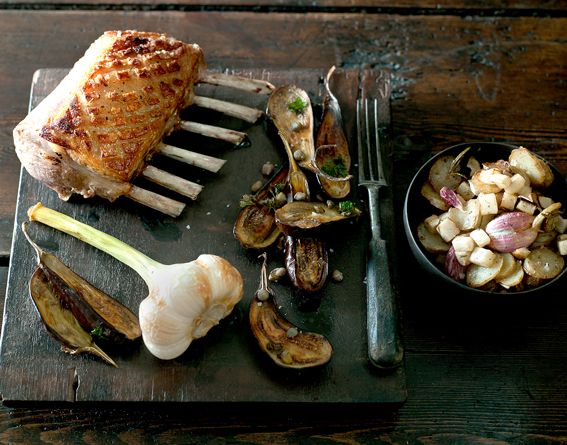 Lamb – whether spiced and charred in the tandoor, coated with a herb crust and roasted, or simply sliced thinly and served in a sandwich with mustard, parsley and cucumber yoghurt – is a great meat for any time of year. This recipe, which pairs lamb with aubergine, is great for a roast lunch.Serves: 4 peoplePreparation time: 15 minutesCooking time: 40 minutes, plus restingIngredients 2 racks of lamb, French-trimmed with scored fat8 baby aubergines, cut in half lengthwise1 bulb of fresh garlic (use aged if not available)4 cloves of aged garlic400g Anya potatoes, thinly sliced4 turnips, trimmed and quartered1 sprig of rosemary3 tbsp capers3 tbsp chopped parsleySplash of VermouthOlive oilSalt and pepper to seasonMethodHeat the oven to 200°C and put the potatoes, turnips, garlic cloves, rosemary and aubergine in a roasting tray. Liberally shake around with olive oil, salt and pepper and put in the oven for 15 minutes.
Lamb – whether spiced and charred in the tandoor, coated with a herb crust and roasted, or simply sliced thinly and served in a sandwich with mustard, parsley and cucumber yoghurt – is a great meat for any time of year. This recipe, which pairs lamb with aubergine, is great for a roast lunch.Serves: 4 peoplePreparation time: 15 minutesCooking time: 40 minutes, plus restingIngredients 2 racks of lamb, French-trimmed with scored fat8 baby aubergines, cut in half lengthwise1 bulb of fresh garlic (use aged if not available)4 cloves of aged garlic400g Anya potatoes, thinly sliced4 turnips, trimmed and quartered1 sprig of rosemary3 tbsp capers3 tbsp chopped parsleySplash of VermouthOlive oilSalt and pepper to seasonMethodHeat the oven to 200°C and put the potatoes, turnips, garlic cloves, rosemary and aubergine in a roasting tray. Liberally shake around with olive oil, salt and pepper and put in the oven for 15 minutes.
- Meanwhile, heat a heavy pan and sear the lamb until the fat is golden and the meat is lightly browned. Season a little and place on top of the vegetables in the oven. Turn the heat down to 120°C and cook for around 20 minutes.
- Remove from the oven, take out the veg and lamb and leave to rest somewhere warm. Deglaze the roasting tray with the Vermouth and strain the juices into a jug.
- Dress the aubergine with parsley and capers and serve everything together. You can carve the lamb first if you prefer, but I think it looks great whole to carve at the table.
How to food style itAs well as tasting great, food needs to look good on the plate. Here are some tips to make yours sing:
- Serve it on a rustic board or square plate, preferably of a dark colour to create a contrast with the meat and garlic.
- Make your lamb look appetising and golden brown by ensuring you score and sear the meat. The French-trimmed white bones are also essential for making the meat the visual and appetising. Ensure they are wrapped in foil during the roasting.
- Finally, don’t overdo it – spread the ingredients out delicately, so that you can see each piece of food clearly. Put any extra vegetables in a bowl to the side.
Spiced peaches with Amaretti crumbs and sage syrup
 A ripe peach is a thing of beauty; soft and juicy, slightly messy and best eaten over the sink. Peaches also go really well with rich meats, but in this instance I roasted them in spices and a little wine to serve as a simple pudding. They respond really well to spices, and especially the aniseed and floral flavours of Szechuan pepper. The Amaretti biscuits complement the natural almondy flavour found in peach stones. Serves: 4Prep time: 10 minsCooking time: 35-40 minsIngredients8 peaches, on the firm side of ripe4 star anise1 cinammon stick1 tsp ground Szechuan peppercorns2 vanilla pods1 tsp ground allspice2 tbsp caster sugar1 small glass white wine (Sancerre or Gewürtztraminer are good)4-6 Amaretti biscuits, crushedA few lavender leaves and toasted almonds to garnishFor the syrup:60g caster sugar100ml water8 sage leavesMethod
A ripe peach is a thing of beauty; soft and juicy, slightly messy and best eaten over the sink. Peaches also go really well with rich meats, but in this instance I roasted them in spices and a little wine to serve as a simple pudding. They respond really well to spices, and especially the aniseed and floral flavours of Szechuan pepper. The Amaretti biscuits complement the natural almondy flavour found in peach stones. Serves: 4Prep time: 10 minsCooking time: 35-40 minsIngredients8 peaches, on the firm side of ripe4 star anise1 cinammon stick1 tsp ground Szechuan peppercorns2 vanilla pods1 tsp ground allspice2 tbsp caster sugar1 small glass white wine (Sancerre or Gewürtztraminer are good)4-6 Amaretti biscuits, crushedA few lavender leaves and toasted almonds to garnishFor the syrup:60g caster sugar100ml water8 sage leavesMethod
- Heat the oven to 180°C.
- Slice and stone the peaches, lay them on a roasting tray and scatter over the remaining ingredients and pour in the wine.
- Roast in the oven for about 35 minutes, or until nice and soft but still holding their shape.
- Meanwhile, make the syrup by bringing the sugar and water to a boil, then stirring until the sugar disolves. Simmer hard for another five minutes or so, until you have a nice syrup. Add the sage leaves and leave to infuse while the peaches finish cooking. Remove the sage leaves before serving.
- Leave the peaches to cool for a while, and serve with the crushed Amaretti sprinkled over and some of the syrup. If you like, you could also serve with ice cream or very cold Eiswein.
How to food style it
- The colour of these peaches is wonderful, so be sure to choose a plate that brings that out. I normally prefer white but in this case a grey would work well.
- Place one half, cut side up on the plate, slightly off centre then rest the other one at an angle against it, again, cut side up.
- Sprinkle the crumbs over the peaches, put one of the star anise on the plate along with the almonds and lavender leaves. Pour over a little syrup.
In a pickle
 I must admit, I set out thinking more about the shapes and colours of this pickled vegetable dish before the flavours, as I couldn’t resist the red of radish against the bright green of cress leaves. Strong, vivid colours will always make a dish look more appetising – which must appeal to our natural instincts for healthy food – and pickling is a great way to intensify those colours.Pickling also creates a sharp contrast of flavours to freshen the palate, and everything here was so sharp, sweet, crunchy and fresh that I was hard pressed not to eat it straight from the bowl.This dish would work well with lightly-spiced chicken, steamed sea bream and lemongrass, or perhaps scallops quickly sautéed in butter and orange zest.Serves: 4Prep time: 10 mins, plus pickling timeIngredients16 radishes, sliced as thinly as possible2 tbsp mustard cress10cm cucumber, sliced as thinly as possible1 head of Shimeji mushrooms, sliced from the base2 tbsp caster sugar2 tbsp white wine vinegar1 tbsp Mirin2 tsp Japanese rice vinegarMethod
I must admit, I set out thinking more about the shapes and colours of this pickled vegetable dish before the flavours, as I couldn’t resist the red of radish against the bright green of cress leaves. Strong, vivid colours will always make a dish look more appetising – which must appeal to our natural instincts for healthy food – and pickling is a great way to intensify those colours.Pickling also creates a sharp contrast of flavours to freshen the palate, and everything here was so sharp, sweet, crunchy and fresh that I was hard pressed not to eat it straight from the bowl.This dish would work well with lightly-spiced chicken, steamed sea bream and lemongrass, or perhaps scallops quickly sautéed in butter and orange zest.Serves: 4Prep time: 10 mins, plus pickling timeIngredients16 radishes, sliced as thinly as possible2 tbsp mustard cress10cm cucumber, sliced as thinly as possible1 head of Shimeji mushrooms, sliced from the base2 tbsp caster sugar2 tbsp white wine vinegar1 tbsp Mirin2 tsp Japanese rice vinegarMethod
- Mix together the sugar and liquid ingredients in a bowl and stir well until the sugar has dissolved.
- Add the remaining ingredients, apart from the cress, and stir gently, making sure they are covered by the vinegar. Set aside and leave to pickle for half an hour or so.
- Scatter over the cress and serve as a side dish or pile delicately on the plate with your chicken or fish.
How to food style it
- If serving in the bowl as a side dish, just make sure everything can be seen. The white inner circles of the radish make great ‘frames’ for the cress and mushrooms. Try and fold the cucumber in nice waves throughout.
- If serving directly on the plate, it’s nice to space all of the elements out and create a graphic pattern on the plate to then place the other elements in and around.
- Use the pink sugary vinegar left in the bowl to create vivid spots and drizzles on the plate.
Fig and goat’s cheese tart with onions, tomatoes and honey
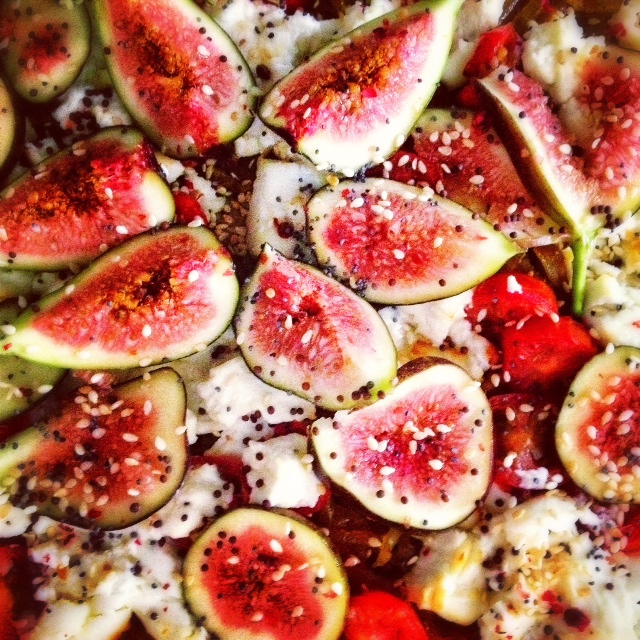 When I was at my parents’ last weekend for my dad’s birthday, I wanted to contribute something to the lunch, and brought in the figs I happened to have left over from the day before. I started first thing in the morning by caramelising some onions over a very low heat, until they turned a sweet golden brown. Nearer to lunchtime, a quick assembly of the onion, figs, goat’s cheese and tomato created a simple and pretty puff pastry tart. I didn’t, but you could add some crisped parma ham at the end to give it a little extra texture and saltiness.Serves: 6-8 as a starterPrep time: 25 minsCooking time: 1 hour for the onions, plus 25 mins for the restIngredients1 sheet of ready-rolled puff pastry4 white onions, thinly sliced, though red would work well too1 tsp sugar1 thyme sprig8 figs, quartered150g crumbly goat’s cheese8 cherry tomatoes1 tbsp poppy seeds1 tbsp sesame seeds1 tbsp honeyOlive oilLemon zest2 tsp balsamic vinegar, thickened slightly in a hot pan and left to coolA handful of lamb’s lettuce to garnishSalt and pepper to seasonMethod
When I was at my parents’ last weekend for my dad’s birthday, I wanted to contribute something to the lunch, and brought in the figs I happened to have left over from the day before. I started first thing in the morning by caramelising some onions over a very low heat, until they turned a sweet golden brown. Nearer to lunchtime, a quick assembly of the onion, figs, goat’s cheese and tomato created a simple and pretty puff pastry tart. I didn’t, but you could add some crisped parma ham at the end to give it a little extra texture and saltiness.Serves: 6-8 as a starterPrep time: 25 minsCooking time: 1 hour for the onions, plus 25 mins for the restIngredients1 sheet of ready-rolled puff pastry4 white onions, thinly sliced, though red would work well too1 tsp sugar1 thyme sprig8 figs, quartered150g crumbly goat’s cheese8 cherry tomatoes1 tbsp poppy seeds1 tbsp sesame seeds1 tbsp honeyOlive oilLemon zest2 tsp balsamic vinegar, thickened slightly in a hot pan and left to coolA handful of lamb’s lettuce to garnishSalt and pepper to seasonMethod
- Heat a frying pan over a medium heat and add some olive oil, the onions, thyme and a little salt and sugar. Stir occasionally and cook until they start to become translucent. Turn the heat down and cover with a lid. Check occasionally, stirring to make sure they don’t stick or burn. Cook for 45-50 minutes or until they are golden brown, sweet and rich.
- Nearer to lunchtime, heat the oven to 180°C and roll the pastry onto a baking sheet. Prick the middle with a fork so it doesn’t rise too much, and score a 1cm border all the way around. Cook for 15-20 minutes then remove from the oven and spread the onions over it. Arrange the figs, goat’s cheese and tomatoes on top, sprinkle with the seeds, and drizzle with the oil, honey, balsamic and lemon zest.
- Season well and when cooled a little, top with the lamb’s lettuce.
How to food style it
- The pastry sheet really is a blank canvas, and with this tart the ingredients do all the work for you. Purple figs against pure whites, golden olive oil and green leaves are going to work, almost however you throw them down. Do try to build in balanced layers, making sure that every section of the tart has a good mix of the ingredients.
- Finally, drizzle with oil and seeds to unify the surface and scatter leaves gently across, taking care to not hide the rest of the ingredients.
Beautiful bubble and squeak
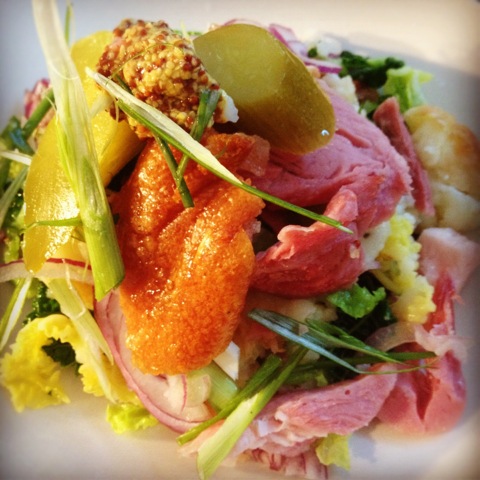 In our house, it’s pretty rare for there to be any crackling left over from a roast pork – or, come to think of it, much pork. But when that does happen, I like making this version of bubble and squeak for brunch the next day. This deserves to be a dish in its own right, so it is even worth making it from scratch.Serves: 4Cooking time: 20 minsIngredientsUse whatever leftovers you have from the roast, or failing that:Shredded slow roast gammon and shattered crackling10 roast potatoes, lightly crushed with a fork½ a Savoy cabbage, finely sliced and blanched in salted water3 spring onions, shredded1 red onion, finely sliced1 tbsp Olive oil and tbsp butter to fry (or use the gammon dripping)3 dill cucumber picklesSalt and pepper to seasonMethod
In our house, it’s pretty rare for there to be any crackling left over from a roast pork – or, come to think of it, much pork. But when that does happen, I like making this version of bubble and squeak for brunch the next day. This deserves to be a dish in its own right, so it is even worth making it from scratch.Serves: 4Cooking time: 20 minsIngredientsUse whatever leftovers you have from the roast, or failing that:Shredded slow roast gammon and shattered crackling10 roast potatoes, lightly crushed with a fork½ a Savoy cabbage, finely sliced and blanched in salted water3 spring onions, shredded1 red onion, finely sliced1 tbsp Olive oil and tbsp butter to fry (or use the gammon dripping)3 dill cucumber picklesSalt and pepper to seasonMethod
- Mix together all the ingredients in a bowl and season well.
- Heat a frying pan and add the oil and butter until hot.
- Throw in the cabbage and potatoes, cook well, adding the red and spring onion at the last minute.
- Serve on warm plates with shredded cooked ham, crackling and sliced pickles, with a touch of wholegrain mustard.
How to food style it
- With this one, the cabbage forms a great base to structure the flakes of meat, potatoes and onions on. Try to give it form and height.
- Laying shards of crackling and slivers of spring onion on top helps give it elegance and leads your eye across the whole dish, bringing everything together.
- A spoon of mustard and some sliced pickles finish it off, keeping it elegant while still remaining rustic. It is, after all, a dish of leftovers.
An artistic Eton Mess
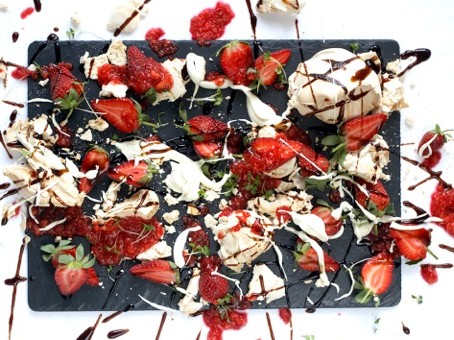 Most people love strawberries, meringues and cream, but not me. I just don’t get on well with the cream, yet I love the idea and the ‘Englishness’ of the Mess. My version uses natural yoghurt with a little vanilla added, but you could use lightly whipped cream if you prefer. If you can get some wild strawberries, they make an excellent addition, while the balsamic, cress, thyme and pepper add a flavour punch, as well as being visually exciting.Talking of which, my aim here was to make the whole thing to look like a Jackson Pollock painting.Serves: 4 peopleCooking time: 1 hr (or 10 mins if you buy meringues)Ingredients2 punnets of strawberries, 1 halved, 1 puréed with a little sugar100ml natural yoghurt, with a little vanilla extract added4 fist-sized meringues, bought or home-madeA few thyme sprigs1 small bunch of salad cressA small bottle of balsamic syrup (or make your own by reducing 100ml of balsamic until you have a syrup)2 tbsp olive oilA pinch of freshly ground black pepperMethod
Most people love strawberries, meringues and cream, but not me. I just don’t get on well with the cream, yet I love the idea and the ‘Englishness’ of the Mess. My version uses natural yoghurt with a little vanilla added, but you could use lightly whipped cream if you prefer. If you can get some wild strawberries, they make an excellent addition, while the balsamic, cress, thyme and pepper add a flavour punch, as well as being visually exciting.Talking of which, my aim here was to make the whole thing to look like a Jackson Pollock painting.Serves: 4 peopleCooking time: 1 hr (or 10 mins if you buy meringues)Ingredients2 punnets of strawberries, 1 halved, 1 puréed with a little sugar100ml natural yoghurt, with a little vanilla extract added4 fist-sized meringues, bought or home-madeA few thyme sprigs1 small bunch of salad cressA small bottle of balsamic syrup (or make your own by reducing 100ml of balsamic until you have a syrup)2 tbsp olive oilA pinch of freshly ground black pepperMethod
- Hull one punnet of strawberries and put in a blender with a pinch of sugar. Blitz until smooth and put in the fridge while you assemble the rest.
- Crush half the meringues and lightly break the other half. Scatter on a plate or board and add the strawberries. Give it a twist of pepper, and sprinkle over the thyme and cress. Spoon over the yoghurt and purée, then pour over the balsamic syrup and serve immediately.
How to food style it
- This one is great fun to do and is just like being back at school with some paints. A dark, rectangular surface really helps the reds and whites stand out; I used slate here.
- This is a question of balance on the plate, keep everything well defined by not piling it up or putting it too close together.
- Be really free and loose with the sauces, don’t be scared to make a mess and make bold, sweeping strokes with them.













